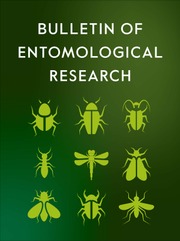Article contents
The predatory and sexual behaviour of Phonoctonus fasciatus (P. de B.) and P. subimpictus Stål (Hem., Reduviidae)
Published online by Cambridge University Press: 10 July 2009
Extract
Observations on the behaviour of the predatory Reduviids Phonoctonus fasciatus (P. de B.) and P. subimpictus Stål were made in the laboratory. The sequence of events in the response to normal prey (Dysdercus superstitiosus (F.)) is described. The preferred site of the first puncture with adult prey was an antennal base, or the same region and the neck with nymphs. A strong tendency for the Reduviid to move its proboscis tip towards the prey's head region implied some perception of body form, which was found to depend on the presence of the prey's appendages. Such perception had no apparent influence on the intensity of the predatory response, experiments with models showing the most important visual stimulus eliciting attack to be that of movement. The scent of the prey greatly augmented the response to models, and chemical stimuli are presumably the basis on which the prey is selected and conspecific individuals, which resemble the prey in appearance, are recognised. The rarity of cannibalism by the adults showed such recognition to be well established, but sexual discrimination was minimal, both males and females behaving almost identically towards either sex. Adults of the two Phonoctonus species also failed to discriminate between their own and the alternative species, but since attempts at cross mating were unsuccessful their separate specific status seems justified.
- Type
- Original Articles
- Information
- Copyright
- Copyright © Cambridge University Press 1972
References
- 16
- Cited by


